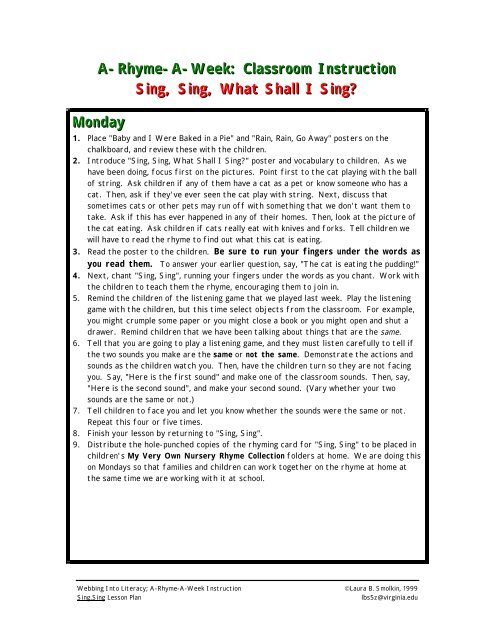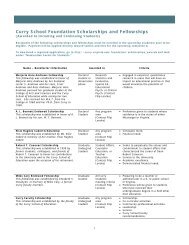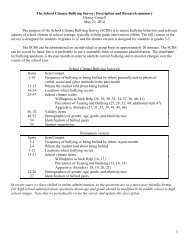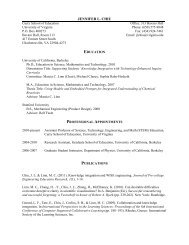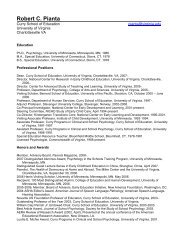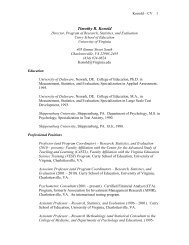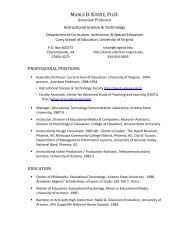A-Rhyme-A-Week: Classroom Instruction - Curry School of Education
A-Rhyme-A-Week: Classroom Instruction - Curry School of Education
A-Rhyme-A-Week: Classroom Instruction - Curry School of Education
Create successful ePaper yourself
Turn your PDF publications into a flip-book with our unique Google optimized e-Paper software.
A-<strong>Rhyme</strong>-A-<strong>Week</strong>: Cllassroom Instructiion<br />
Siing, Siing, What Shallll I Siing?<br />
Monday<br />
1. Place "Baby and I Were Baked in a Pie" and "Rain, Rain, Go Away" posters on the<br />
chalkboard, and review these with the children.<br />
2. Introduce "Sing, Sing, What Shall I Sing?" poster and vocabulary to children. As we<br />
have been doing, focus first on the pictures. Point first to the cat playing with the ball<br />
<strong>of</strong> string. Ask children if any <strong>of</strong> them have a cat as a pet or know someone who has a<br />
cat. Then, ask if they've ever seen the cat play with string. Next, discuss that<br />
sometimes cats or other pets may run <strong>of</strong>f with something that we don't want them to<br />
take. Ask if this has ever happened in any <strong>of</strong> their homes. Then, look at the picture <strong>of</strong><br />
the cat eating. Ask children if cats really eat with knives and forks. Tell children we<br />
will have to read the rhyme to find out what this cat is eating.<br />
3. Read the poster to the children. Be sure to run your fingers under the words as<br />
you read them. To answer your earlier question, say, "The cat is eating the pudding!"<br />
4. Next, chant "Sing, Sing", running your fingers under the words as you chant. Work with<br />
the children to teach them the rhyme, encouraging them to join in.<br />
5. Remind the children <strong>of</strong> the listening game that we played last week. Play the listening<br />
game with the children, but this time select objects from the classroom. For example,<br />
you might crumple some paper or you might close a book or you might open and shut a<br />
drawer. Remind children that we have been talking about things that are the same.<br />
6. Tell that you are going to play a listening game, and they must listen carefully to tell if<br />
the two sounds you make are the same or not the same. Demonstrate the actions and<br />
sounds as the children watch you. Then, have the children turn so they are not facing<br />
you. Say, "Here is the first sound" and make one <strong>of</strong> the classroom sounds. Then, say,<br />
"Here is the second sound", and make your second sound. (Vary whether your two<br />
sounds are the same or not.)<br />
7. Tell children to face you and let you know whether the sounds were the same or not.<br />
Repeat this four or five times.<br />
8. Finish your lesson by returning to "Sing, Sing".<br />
9. Distribute the hole-punched copies <strong>of</strong> the rhyming card for "Sing, Sing" to be placed in<br />
children's My Very Own Nursery <strong>Rhyme</strong> Collection folders at home. We are doing this<br />
on Mondays so that families and children can work together on the rhyme at home at<br />
the same time we are working with it at school.<br />
Webbing Into Literacy; A-<strong>Rhyme</strong>-A-<strong>Week</strong> <strong>Instruction</strong><br />
Sing,Sing Lesson Plan<br />
©Laura B. Smolkin, 1999<br />
lbs5z@virginia.edu
Tuesday<br />
1. Begin by putting the poster back on the blackboard. Ask the children if they can<br />
remember what 2 things the playful cat had run away with.<br />
2. Remind the children that Tuesday is "acting" day. To act out this week's rhyme, you will<br />
need 2 children for each performance. One, <strong>of</strong> course, is the cat. You can talk with the<br />
children about "being a cat", pretending to lick their paws to clean them and so forth.<br />
The cat must listen carefully to be ready to run <strong>of</strong>f with first the pudding string and<br />
then the pudding. The other actor is the "singer" <strong>of</strong> this story. The Baring-Gould's<br />
(1962) remind us <strong>of</strong> Little Tommy Tucker who had to "sing for his supper." This is<br />
exactly what traveling entertainers used to have to do. So, the actor who is "telling this<br />
tale" should do so in a very exaggerated fashion. For "What shall I sing?" the actor can<br />
spread his or her arms wide as if asking a large audience. For "What shall I do?", the<br />
actor can place his or her hands on either side <strong>of</strong> his or her head.<br />
3. Vary the chanting. You might divide your students into a boys' group and a girls' group<br />
and seat them facing each other. Then, you can alternate who speaks the actor's lines<br />
("Sing, sing, what shall I sing?") with who speaks the commentator lines ("The cat's run<br />
away with the pudding string"). Or, you might have the actor lines spoken in a loud,<br />
wailing tone while the commentator lines are whispered.<br />
4. Finish this lesson with your cloze activity. Use the following lines in particular:<br />
Sing, sing<br />
What shall I ____<br />
The cat's run away<br />
With the pudding ____.<br />
Webbing Into Literacy; A-<strong>Rhyme</strong>-A-<strong>Week</strong> <strong>Instruction</strong><br />
Sing,Sing Lesson Plan<br />
©Laura B. Smolkin, 1999<br />
lbs5z@virginia.edu
Wednesday<br />
1. Put the "Sing, sing" poster on the blackboard, then run your fingers under the words as<br />
you chant the rhyme. Repeat the cloze activity from Tuesday, having children fill in the<br />
missing words.<br />
2. Remind the children that sing and string rhyme, and we are going to learn some other<br />
words that rhyme. Introduce these pictures from the picture card set: bring, cling,<br />
ding, fling, king, ring, sing, sting, string, and swing. (There are other pictures you<br />
may include as well.) Be sure to explain to the children what the word and picture mean.<br />
Take the time to talk about the pictures, relating them to what your children have seen<br />
and know. Always remember, if there is a picture that you feel is unsuitable for<br />
your particular classroom, you can eliminate this picture from the set.<br />
3. Most <strong>of</strong> these words can be pantomimed or acted out. For instance, you can ask children<br />
to demonstrate how to "bring" something to someone or how to fend <strong>of</strong>f a "sting".<br />
4. Remind children that last week we sorted by rhyming sounds. As we worked with ot<br />
rimes last week, we'll contrast the ot rime with this week's ing rime. Use the following<br />
pictures: sing, string, king, ring, and hot, pot, knot and shot. Call children's<br />
attention to the words "sing" and "string" in the nursery rhyme poster. Then, tape the<br />
picture for hot at the top <strong>of</strong> one column and the picture for sing at the top <strong>of</strong> the<br />
other. Place all other pictures in the chalk tray, saying each one's name.<br />
5. Remind the children that we've been talking about things that are the same. When<br />
words end the same, we say that they rhyme.<br />
6. Call children one at a time to take a picture and decide if it ends the same as hot or<br />
sing. Keep in mind that many children are working to hear and understand "rhyming" and<br />
"same-ness". If a child is hesitant, go ahead and support him or her with the task.<br />
7. Finish today's lesson by chanting "Sing, Sing, What shall I sing?"<br />
Thursday<br />
1. Select 5 or 6 <strong>of</strong> the downloadable riddle cards that you think are best suited for your<br />
students.<br />
2. Begin by putting the "Sing, Sing" poster back on the blackboard. Ask children to chant<br />
the rhyme, allowing 2 or 3 at a time to chant or sing the rhyme for the class.<br />
3. Set the pictures from the picture card set on the chalk tray. Tell the children that<br />
today we will be guessing the answers to some riddles. The answer to the riddle will be<br />
one <strong>of</strong> the pictures we looked at yesterday.<br />
4. Put the riddle cards on the board one at a time. Read the riddle, then help your<br />
students decide which picture best answers the riddle. Tape the picture at the bottom<br />
<strong>of</strong> the riddle card. You read the riddle, letting the children fill in the missing word,<br />
completing the rhyme by saying the name <strong>of</strong> the picture.<br />
5. Finish the lesson as you did on Tuesday, having the children supply the missing word at<br />
the end <strong>of</strong> each line <strong>of</strong> the rhyme.<br />
Webbing Into Literacy; A-<strong>Rhyme</strong>-A-<strong>Week</strong> <strong>Instruction</strong><br />
Sing,Sing Lesson Plan<br />
©Laura B. Smolkin, 1999<br />
lbs5z@virginia.edu
Friiday<br />
1. Remind the children <strong>of</strong> the various activities you've done this week, and tell them that<br />
this is Children's Choice day. Display 3 different rhyme posters -- Sing, Sing, Jack<br />
Be Nimble, and Baby and I Were Baked in a Pie.<br />
2. Let the children decide which rhymes they would like to act out, to chant, to sort<br />
pictures for, or to do the riddle rhymes for.<br />
3. Record the children's choices on the board using the written list as the order to follow.<br />
Then complete the activities.<br />
4. Finish by chanting "Sing, sing, what shall I sing?" Have all the children pretend they are<br />
actor who is telling this tale to earn his or her supper.<br />
5. Remind children to look at their My Very Own Nursery <strong>Rhyme</strong> Collections with their<br />
families over the weekend.<br />
Webbing Into Literacy; A-<strong>Rhyme</strong>-A-<strong>Week</strong> <strong>Instruction</strong><br />
Sing,Sing Lesson Plan<br />
©Laura B. Smolkin, 1999<br />
lbs5z@virginia.edu


